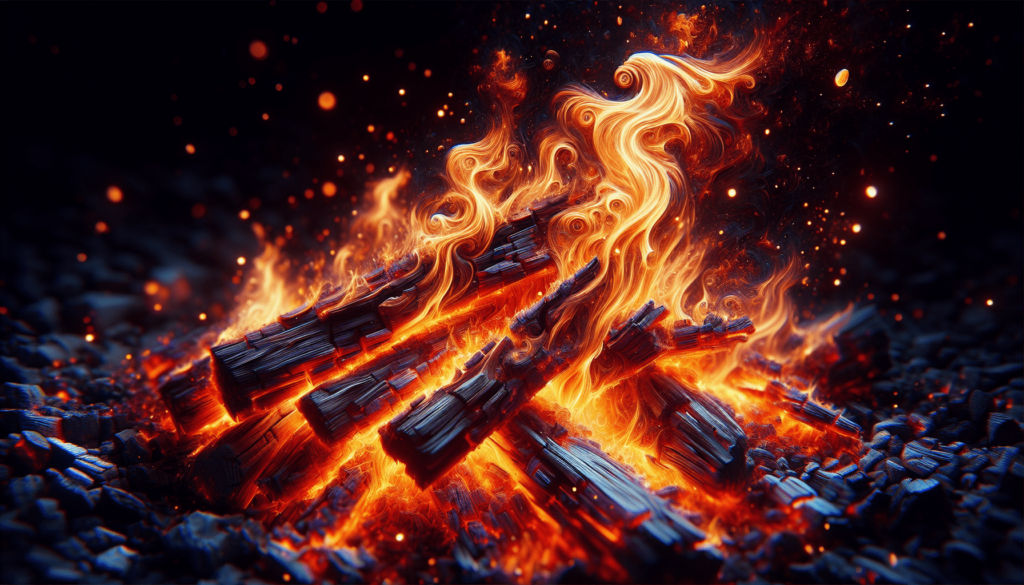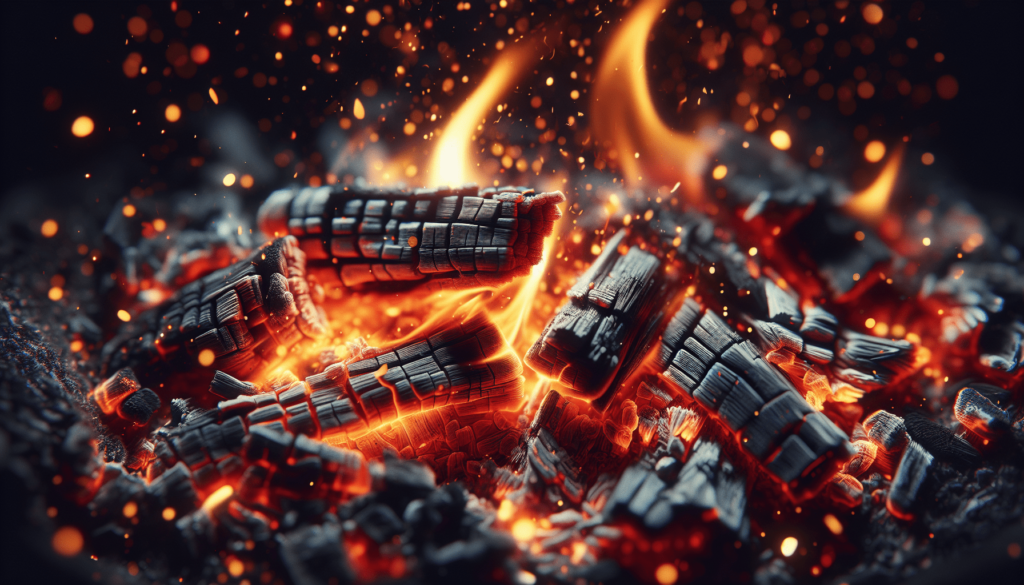When I first learned about the different types of chemical reactions, I never realized how fascinating it could be to classify everyday occurrences, like burning wood. In the article “What Type Of Reaction Is Burning Wood Classified As?”, I delve into the fiery phenomenon we often take for granted. It turns out that burning wood is an intricate mix of decomposition and combustion reactions. As wood burns, it breaks down into simpler substances while simultaneously combining with oxygen to produce heat, light, and new compounds like carbon dioxide and water. Understanding these reactions not only satisfies my curiosity but also deepens my appreciation for the complex science behind the crackling warmth of a fire. Have you ever wondered what type of reaction burning wood is classified as? It’s the kind of query that might pop into your head while roasting marshmallows over a campfire or huddling around a wood stove on a brisk winter night. The beautiful dance of the flames has a way of sparking curiosity.

What Type of Reaction Is Burning Wood Classified As?
Let’s start with the basics: burning wood is a chemical reaction. But not just any chemical reaction. It’s a specific kind known as a combustion reaction. Now, if you’re like me, the word “combustion” probably conjures up images of engines and explosions, but the principle is the same whether we’re talking about the engine of a ’68 Mustang or a cozy crackling fire.
Breaking Down Combustion
Combustion, in simple terms, is the process of burning something. It’s an exothermic reaction, which means it releases heat. When wood burns, it reacts with oxygen in the air to give off heat and light. This is why we find fires so mesmerizing—they’re essentially light and heat shows.
Much like when I discovered that bicycle repair isn’t just about slapping on a new tire, understanding combustion gets into some chemistry nitty-gritty. Specifically, it’s a complex interplay of:
- Oxygen (O2): The essential element that supports combustion.
- Fuel (in this case, wood): The substance that burns.
- Heat: The energy required to start the reaction.
Think of it like baking a cake. You need your flour, sugar (fuel), an oven (heat), and air (oxygen) for the magic to happen.
The Chemistry of Burning Wood
Now, let’s dissect what exactly is going on when we have a roaring fire.
The Three Phases
The burning of wood can be split into three main phases:
-
Dehydration: Before the actual combustion begins, the wood loses water content. Any moisture in the wood evaporates as it’s heated. This is why wet wood doesn’t burn as well—it’s too busy turning into steam.
-
Pyrolysis: This is where the wood starts to break down chemically but without oxygen. The heat causes the wood to decompose into smaller molecules. It releases gases (like carbon monoxide, hydrogen, and methane) and leaves behind charcoal.
-
Combustion: Finally, the gases and charcoal produced in the pyrolysis phase react with oxygen. The volatile gases burn in the flame, producing heat and light, while the charcoal burns slower, glowing with a red, hot intensity.
The Chemical Reaction
The simplest way to look at the chemical reaction is with a basic equation:
[ \text + \text_2 \longrightarrow \text_2 + \text ]
This reads as carbon in the wood reacting with oxygen to produce carbon dioxide, along with releasing light and heat.
Examples of Combustion Reactions
Wood isn’t the only thing that undergoes combustion. Whether it’s your car’s engine, a candle, or a backyard barbecue, they all follow the same fundamental chemical principles.
| Example | Fuel | Outcome |
|---|---|---|
| Car Engine | Gasoline | Carbon dioxide, water vapor, energy |
| Candle | Wax | Water vapor, carbon dioxide, heat, light |
| Backyard Barbecue | Charcoal | Carbon dioxide, heat, light |
Everyday items burning may better illustrate how universal these principles are. Whether I’m igniting a birthday candle or revving the Harley, I’m witnessing combustion in action.
The Role of Heat in Combustion
The importance of heat in this process can’t be overstated. If you’ve ever tried to light a damp log, you know how vexingly resistant wood can be to catching fire without the proper heat. So, let’s delve into why heat is such a big deal.
Ignition Temperature
Every material has a specific ignition temperature—the temperature at which it starts to combust. For wood, this sits around 300-400 degrees Fahrenheit (150-200 degrees Celsius). If the wood isn’t hot enough, it won’t reach the pyrolysis phase, and without pyrolysis, there’s no combustible gas to ignite.
Sustaining Combustion
Once the wood catches fire, the heat generated by the reaction helps to sustain it. This is where those lessons in fire-making from Scouts or camping come handy—more logs mean more heat, and more heat means the fire sustains itself better. It’s like adding friends to a party; the more, the merrier.
The logs themselves act like small batteries of energy fuel. As the wood burns, the reaction releases that stored energy in forms of heat and light, turning the cold air around it warm and the night sky slightly brighter.
What Affects Combustion?
You might be wondering what factors influence this whole combustion process. It isn’t as straightforward as lighting a match and standing back. Several factors come into play, complicating the roaring blaze we associate with a good bonfire.
Moisture Content
Wood with high moisture content won’t burn as efficiently because energy gets diverted to evaporate the water first. Think of wet wood as the mood-killer at a dance party—nobody wants to deal with it, and it seriously dampens the good times.
Oxygen Supply
When wood burns in an environment with limited oxygen, it undergoes incomplete combustion. This means carbon monoxide is produced instead of carbon dioxide. Generate carbon monoxide in an enclosed space, and you’ve got a serious health hazard on your hands. This is why proper ventilation in fireplaces and wood stoves is crucial.
Wood Type
Different types of wood have different burning characteristics. Hardwoods, like oak and hickory, burn slower and hotter, making them advantageous for prolonged fires. Softwoods, like pine, burn faster but aren’t as hot, often leaving more residue or ash.
Temperature
Engines, stoves, and even simple campfires work best when they can achieve and maintain a high enough temperature to keep the combustion reaction going. This is why we often add kindling to larger logs—to get the fire hot and keep it sustained.
Some Curious Questions About Combustion
Anyone who’s had the pleasure of staring into a fire and contemplating life (I recommend it highly for meditation purposes) knows that burning wood spurs a ton of questions—questions worth exploring.
Why Do We Use Wood?
Wouldn’t a volcanic rock serve the same purpose, or perhaps old homework assignments? While many things can burn, wood strikes a beautiful balance between availability, ease of use, and efficiency. It’s nature’s own easily attainable fuel source and lets face it—a stone fireplace looks much better stacked with logs than logs of homework.
Can Anything Stop the Reaction?
Fire extinguishers, obviously, are the go-to for combating unwanted fires. They typically work through one or more mechanisms:
- Removing heat (water-based extinguishers)
- Smothering oxygen (foam or CO2 extinguishers)
- Inhibiting the chemical reaction (dry chemical extinguishers)
Each method targets specific aspects of the combustion triangle—oxygen, heat, and fuel.

History and Civilization’s Interaction with Wood Combustion
Before we move on to further technicalities, let’s pause for a historical interlude.
From Fire Discoveries to Heating Homes
The discovery of fire, and by extension wood combustion, dates back hundreds of thousands of years. Early humans used fire to cook food, ward off predators, and survive in harsh climates. Fire represented a technological leap, and mastering wood combustion was like discovering a primordial iPhone—it changed everything.
Industrial and Modern Uses
With time, humanity’s relationship with wood combustion evolved. From blacksmithing forges of medieval times to wood stoves in rural America, the applications of wood burning evolved. Today, while alternative forms of energy (gas, electric, solar) have taken over to some extent, wood still holds a revered, almost poetic role in hearths and homes.
Environmental Impact of Wood Burning
Burning wood is not without its drawbacks, particularly when it comes to the environment. While appreciating the cozy ambiance, it’s also worth contemplating its larger ecological footprint.
Emissions and Pollution
Burning wood releases smoke, which contains a variety of pollutants including:
- Particulate matter
- Carbon monoxide
- Volatile organic compounds (VOCs)
Combined, these can pose health risks, particularly for those with respiratory conditions. Ever wonder why campfire smoke always seems to gravitate toward you? It’s Murphy’s Law… or bad luck, or a clever ploy to keep you half-dancing around the firepit.
Carbon Neutral?
There’s a general belief that wood is a “carbon-neutral” fuel source. While growing, trees absorb CO2, which they release when burned. Ideally, this cycle is balanced. However, aspects like deforestation, inefficient burning, and particulate emissions complicate this picture.
Sustainable Practices
To mitigate environmental impact, there’s a movement towards sustainable forestry and more efficient burning methods. Approaches like using seasoned (dry) wood, installing efficient wood stoves, and adopting proper venting systems can help.
Wrapping It Up
So, what type of reaction is burning wood classified as? It’s a tightly knit symphony of physics and chemistry, a combustion reaction characterized by complexity and wonder. From the phases of dehydration, pyrolysis, and eventual combustion, to historically shaping our evolution and cozying up our winters, wood burning is more than just striking a match.
It’s an ancient dance of atoms and molecules, an expressive ballet of heat and light that’s played a pivotal role in human civilization. But like all good things, it’s best enjoyed with a sense of humility and responsibility to our environment.
And next time you find yourself staring into a fire, mesmerized by the flames, you’ll know you’re watching chemistry in its rawest, most primeval form.
Hope you enjoyed this combustion crash course! Feel free to fire up any more questions you might have—figuratively, of course.

